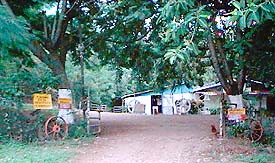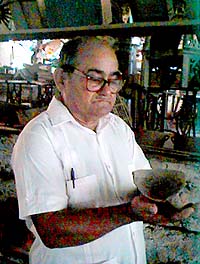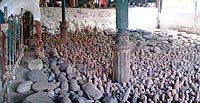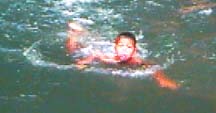| Trujillo Museum
|

|
| Museum entrance |
The Trujillo Museum is one of the major highlights of Trujillo. This
museum is unlike any you're ever likely to visit anywhere else in the World.
If it's a sunny day (and most Trujillan days are,) don't forget to pack
your swimsuit before you go.
The Museum is a ten minute walk going west from the Trujillo Hotel. You
will know you are approaching when you see the huge tractor tire with "Museo"
painted on it. The gate to the museum is only little further, and once
inside on your right you will see a huge rubber tree. Meander a little
more in the courtyard and you will find the remnants of two US military
planes - a Cessna and a Hercules - that crashed in the Contra era. A plaque
commemorates the victims of the crash.
A man approaches us. It is Rufino Galan, director and creator of the Trujillo
Museum. Director Galan tells us that many of the relatives come down once
a year to Trujillo to commemorate the fatal Hercules crash.
Over to the left of the wreckage is an old tractor that is so rusty it
looks like it is melting back into the jungle. A placard describes in great
detail the origins and uses this tractor has had.
|

|
| Director Rudulfo Galan |
After tea we enter the museum. The fee is ridiculously low. If you can,
donate more. The money does not do to waste.
Once inside, one is bombarded by a visual collage of objects; fading photographs,
rusty guns, animal bones, printing presses, molding books, paper money,
stamps, lanterns, moth eaten hats. There is so much stuff that it takes
the breath away. A gramophone is playing in the background. Director Galan
and his son Marvin do their best to keep things in working order. One section
is given over exclusively to old mechanical and simi electric calculators
that are in various stages of decay. Another isle is dedicated to typewriters.
Halfway through the collection the theme changes; Western Civilization
is left behind and one is confronted by a bewildering collection of Pre
Colombian artifacts. The collection would have archaeologists tearing out
their hair; original artifacts stand side by side with contemporary look-alikes.
Many years ago Director Galan discovered a significant find of artifacts
in nearby caves, and ever since there has been significant controversy
over their authenticity. Director Galan is unmoved. Nothing leaves his
museum, he has little regard for academic whims. He tells us however that
there have been some thefts. The burglars stole several of the Pre Colombian
pieces. Strange criminal behavior indeed if the objects were of no value.
|

|
| Hundreds of clay figures |
Museum experiences invariably end up leaving the visitor mentally
exhausted, tired, sleepy, hot, and sweaty. This is where the Trujillo Museum
rises in stature above any other museum we have ever experienced. At best,
other museums have bathrooms and a place to get a snack, but the Trujillo
Museum's back door leads to a botanical delight of giant Bamboo and Spanish
Cedar Trees, Monkeys and Tepasqinte. At the bottom of the incline are four
large pools, fed by the pristine river water of the Rio Crystales which
originates in the pristine National Forest behind Trujillo. There is shaded
areas, small private enclaves and public ones for larger groups of visitors.
A rope bridge crosses the Rio Crystales affording the observer a beautiful
view up towards the jungle forest.
|

|
| Mountain fed pools |
The pools are different depths, one suitable for kids and a deeper one
for more experienced swimmers. We dive in. The water is cool and refreshing.
Birdsong fills the air. Butterflies fly by; it is paradise.
Many people would consider the bulk of Director Galan's collection
nothing more than a collection of junk. This is because we have been taught
that a museum should be an institution for the preservation of the past,
where objects are, explained and placed in context. At the Trujillo museum
- as in real life - objects are in process; here no attempt has been made
to stem the inevitable tide of entropy. Hats rot, photos fade. Director
Galan's gramophone will eventually resist one more repair. The visitor
is confronted with the fact that eventually all will turn to dust. It is
only that at this museum it will happen a little sooner.
The affirmation of life that takes place behind the museum rounds off the
harsh realization of material decay. When you leave the Trujillo Museum,
you leave physically and spiritually refreshed.
In a wealthier country, Director Galan's Museum would be the recipient
of grants and endowments. In our opinion he'd be a shoo-in for a McArthur
Foundation award. But Honduras is a poor country; there is no rewards for
inspired projects such as this. Even in Trujillo Director Galan many consider
him nothing more than a harmless crank. The local government merely taxes
his museum. Times are tough. However, Rulfino Galan has been collecting
and constructing for twenty two years and shows no sign of letting up.
His son, Marvin Galan helps him with the endless work of expansion and
upkeep. The museum will be here when you are ready.
| More pictures of the Museum
|

|



